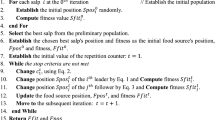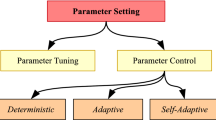Abstract
Metaheuristic algorithms are well-known and widely used strategies for tackling optimization issues. Each has advantages and limitations and is frequently combined with other algorithms to compensate for flaws. The basic Salp Swarm Algorithm (SSA) is simple to use and often effective when solving real-world optimization problems, but it can sometimes get stuck at local optima, leading to premature convergence. The main reasons for this are the poor population diversity, the lack of exploitable resources, and the exploration capabilities being insufficient. A modified SSA algorithm called quantized SSA (QSSA) is suggested to improve performance. The proposed method has incorporated a mathematical operator called the quantization operator into the basic SSA. The main goal of incorporating quantization operator is to improve population diversity and local usage, which can help in finding the solution space more effectively, thereby enabling faster convergence. The suggested QSSA approach is validated through IEEE-CEC-2014 Basic functions. Further, as an application, the same methodology is used to select the finest features from benchmark datasets while retaining accuracy and reducing neural network complexity.


Similar content being viewed by others
Data availability
The datasets analysed during the current study are available in the KAGGLE repository. https://www.kaggle.com/datasets
Abbreviations
- HCEF:
-
High-conditioned elliptic function
- BCF:
-
Bent-cigar function
- DF:
-
Discuss function
- RBF:
-
Rosenbrock’s function
- AF:
-
Ackley’s function
- WF:
-
Weierstrass function
- GF:
-
Griewank’s function
- RF:
-
Rastrigin’s function
- SF:
-
Schwefel’s function
- KF:
-
Katsuura function
- HCF:
-
HappyCat function
- HGBF:
-
HGBat function
- EGRF:
-
Expanded Griewank’s plus Rosenbrock’s function
- ESF6:
-
Expanded Scaffer’s F6 function
References
Zhan ZH, Shi L, Tan KC, Zhang J (2022) A survey on evolutionary computation for complex continuous optimization. Artif Intell Rev 55(1):59–110
Gong S, Nong Q, Bao S, Fang Q, Du DZ (2022) A fast and deterministic algorithm for Knapsack-constrained monotone DR-submodular maximization over an integer lattice. J Glob Optim 85:15–38
Krishna MM, Panda N, Majhi SK (2021) Solving traveling salesman problem using hybridization of rider optimization and spotted hyena optimization algorithm. Expert Syst Appl 183:115353
Panda N, Majhi SK, Pradhan R (2022) A hybrid approach of spotted hyena optimization integrated with quadratic approximation for training wavelet neural network. Arabian J Sci Eng 47:10347–10363
Wolpert DH, Macready WG (1997) No free lunch theorems for optimization. IEEE Trans Evol Comput 1(1):67–82
Mirjalili S, Gandomi AH, Mirjalili SZ, Saremi S, Faris H, Mirjalili SM (2017) Salp Swarm Algorithm: a bio-inspired optimizer for engineering design problems. Adv Eng Softw 114:163–191
Jain S, Dharavath R (2021) Memetic salp swarm optimization algorithm-based feature selection approach for crop disease detection system. J Ambient Intell Human Comput. https://doi.org/10.1007/s12652-021-03406-3
Xing Z, Jia H (2019) Multilevel color image segmentation based on GLCM and improved salp swarm algorithm. IEEE Access 7:37672–37690
Subramani B, Bhandari AK, Veluchamy M (2021) Optimal Bezier curve modification function for contrast degraded images. IEEE Trans Instrum Meas 70:1–10
Melin P, Miramontes I, Carvajal O, Prado-Arechiga G (2022) Fuzzy dynamic parameter adaptation in the bird swarm algorithm for neural network optimization. Soft Comput 26:9497–9514
Kamel S, Ebeed M, Jurado F (2021) An improved version of salp swarm algorithm for solving optimal power flow problem. Soft Comput 25(5):4027–4052
Dash S, Subhashini KR, Satapathy J (2020) Efficient utilization of power system network through optimal location of FACTS devices using a proposed hybrid meta-heuristic Ant Lion-Moth Flame-Salp Swarm optimization algorithm. Int Trans Electr Energy Syst 30(7):e12402
Majhi SK, Bhatachharya S, Pradhan R, Biswal S (2019) Fuzzy clustering using salp swarm algorithm for automobile insurance fraud detection. J Intell Fuzzy Syst 36(3):2333–2344
Mafarja MM, Mirjalili S (2017) Hybrid whale optimization algorithm with simulated annealing for feature selection. Neurocomputing 260:302–312
Meera S, Sundar C (2021) A hybrid metaheuristic approach for efficient feature selection methods in big data. J Ambient Intell Human Comput 12(3):3743–3751
Gharehchopogh FS, Maleki I, Dizaji ZA (2021) Chaotic vortex search algorithm: metaheuristic algorithm for feature selection. Evolution Intell 1:1–32
Alweshah M, Khalaileh SA, Gupta BB, Almomani A, Hammouri AI, Al-Betar MA (2020) The monarch butterfly optimization algorithm for solving feature selection problems. Neural Comput Appl 34:11267–11281
Sinha AK, Shende P, Namdev N (2022) Uncertainty optimization based feature subset selection model using rough set and uncertainty theory. Int J Inf Technol 14:2723–2739
Nakra A, Duhan M (2022) Deep neural network with harmony search based optimal feature selection of EEG signals for motor imagery classification. Int J Inf Technol 1–15
Karthic S, Manoj Kumar S, Senthil Prakash PN (2022) Grey wolf based feature reduction for intrusion detection in WSN using LSTM. Int J Inf Technol 14:3719–3724
De M, Kundu A (2022) A hybrid optimization for threat detection in personal health crisis management using genetic algorithm. Int J Inf Technol 14:2603–2618
Leung YW, Wang Y (2001) An orthogonal genetic algorithm with quantization for global numerical optimization. IEEE Trans Evol Comput 5(1):41–53
Zhang Q, Leung YW (1999) An orthogonal genetic algorithm for multimedia multicast routing. IEEE Trans Evol Comput 3(1):53–62
Liang JJ, Qu BY, Suganthan PN (2013) Problem definitions and evaluation criteria for the CEC 2014 special session and competition on single objective real-parameter numerical optimization. Computational Intelligence Laboratory, Zhengzhou University, Zhengzhou China and Technical Report, Nanyang Technological University, Singapore, vol 635, p 490
Hussain K, Neggaz N, Zhu W, Houssein EH (2021) An efficient hybrid sine-cosine Harris Hawks optimization for low and high-dimensional feature selection. Expert Syst Appl 176:114778
Author information
Authors and Affiliations
Corresponding author
Rights and permissions
Springer Nature or its licensor (e.g. a society or other partner) holds exclusive rights to this article under a publishing agreement with the author(s) or other rightsholder(s); author self-archiving of the accepted manuscript version of this article is solely governed by the terms of such publishing agreement and applicable law.
About this article
Cite this article
Mahapatra, A.K., Panda, N. & Pattanayak, B.K. Quantized Salp Swarm Algorithm (QSSA) for optimal feature selection. Int. j. inf. tecnol. 15, 725–734 (2023). https://doi.org/10.1007/s41870-023-01161-6
Received:
Accepted:
Published:
Issue Date:
DOI: https://doi.org/10.1007/s41870-023-01161-6




